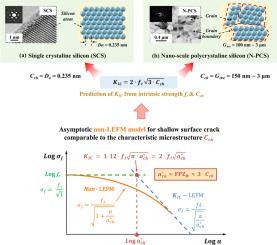单晶与纳米多晶硅的强度-韧性关系由原子/纳米晶微观结构决定
IF 14.3
1区 材料科学
Q1 MATERIALS SCIENCE, MULTIDISCIPLINARY
引用次数: 0
摘要
建立了近似于材料微观结构的浅表面裂纹渐近非lefm模型。单晶硅(SCS)的特征微观结构尺寸(Cch)为原子直径(0.235 nm),纳米多晶硅(N-PCS)的Cch为其平均晶粒尺寸。本研究考虑了粒径在150 nm ~ 3 μm之间的N-PCS。通过其固有强度和各自的Cch可以预测SCS和N-PCS的断裂韧性(KIC)。通过收集到的实验数据,证实了SCS的KIC预测值为0.90 ~ 1.40 MPa√m, N-PCS的KIC预测值为1.56 ~ 5.31 MPa√m, N-PCS的KIC预测值为0.74 ~ 1.38 MPa√m。KIC、本征强度和特征微观结构之间的内在关系具有重要的现实意义和根本意义。宏观的KIC和内在强度,以前被认为是两个独立的材料性质,现在通过原子/纳米尺度的微观结构联系在一起。这种关于脆性固体的强度、韧性和微观结构的基本关系,经SCS和N-PSC验证,可与经典的韧性金属“Hall-Petch关系”相媲美。本文章由计算机程序翻译,如有差异,请以英文原文为准。

Strength-toughness relation of single crystalline and nano-polycrystalline silicon specified by atomic-/nano-crystalline microstructures
An asymptotic non-LEFM model is developed for shallow surface cracks comparable to material microstructures. The characteristic microstructure size (Cch) of single crystal silicon (SCS) is the atomic diameter (0.235 nm), and Cch of a nano-grained polycrystalline silicon (N-PCS) is its average grain size. N-PCS with Cch from 150 nm to 3 μm is considered in this study. The fracture toughness (KIC) of both SCS and N-PCS can be predicted from their intrinsic strengths and respective Cch. Predicted KIC values of 0.90–1.40 MPa √m for SCS and 1.56–5.31 MPa √m for N-PCS are confirmed by collected experimental data of 0.74–1.38 MPa √m for SCS and 1.43–3.46 MPa √m for N-PCS. The intrinsic relation between the KIC, intrinsic strength and characteristic microstructure is both practically useful and fundamentally significant. The macroscopic KIC and intrinsic strength, previously considered as two separate material properties, are now linked together by the atomic-/nano-scale microstructures. This fundamental relation on strength, toughness and microstructure for brittle solids, verified by SCS and N-PSC, is comparable to the classic “Hall-Petch relation” for ductile metals.
求助全文
通过发布文献求助,成功后即可免费获取论文全文。
去求助
来源期刊

Journal of Materials Science & Technology
工程技术-材料科学:综合
CiteScore
20.00
自引率
11.00%
发文量
995
审稿时长
13 days
期刊介绍:
Journal of Materials Science & Technology strives to promote global collaboration in the field of materials science and technology. It primarily publishes original research papers, invited review articles, letters, research notes, and summaries of scientific achievements. The journal covers a wide range of materials science and technology topics, including metallic materials, inorganic nonmetallic materials, and composite materials.
 求助内容:
求助内容: 应助结果提醒方式:
应助结果提醒方式:


